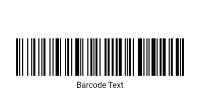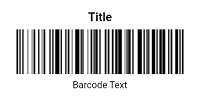Codabar is a linear barcode symbology used primarily for encoding numeric and certain special characters. It is known for its simplicity and reliability, making it a popular choice in libraries, blood banks, and other specialized applications.
Codabar was developed in the early 1970s by the Pitney Bowes Company. Its design was intended to provide a simple yet effective solution for encoding numeric data and a limited set of special characters. Over time, Codabar has been adopted in various industries due to its ease of use and straightforward implementation.
Technical Specifications
Codabar encodes data using a combination of bars and spaces to represent characters. It is designed to be both compact and easy to read. Key features of Codabar include:
- Character Set: Codabar supports numeric digits (0-9) and a set of special characters including
-,.(period),$,+,/, and:. It does not support alphabetic characters. - Start and Stop Characters: Codabar uses four start/stop characters (
A,B,C,D) to indicate the beginning and end of the data sequence. These characters are essential for identifying the barcode format and ensuring accurate scanning. - Check Digit: Codabar does not have a mandatory check digit, though it can be used with optional check digit schemes to improve error detection.
Check Digit Calculation
Although Codabar barcodes do not include a built-in check digit, it is possible to add one for enhanced error checking. The check digit is typically calculated using a modulo 10 algorithm:
- Assign a value to each digit and character in the barcode.
- Sum these values.
- Compute the remainder when this sum is divided by 10.
- The check digit is the difference between 10 and this remainder. If the remainder is 0, the check digit is also 0.
Adding a check digit can help in detecting scanning errors, though it is not a standard feature of Codabar.
Comparison with Other Barcode Symbologies
Compared to Code 39, which supports a wider range of alphanumeric characters, Codabar is more limited in its character set but offers a simpler design. Unlike Code 128, which can encode a full ASCII character set and includes error detection through checksums, Codabar is less complex but does not inherently include error-checking mechanisms. Codabar’s simplicity and compact design make it suitable for specific applications where its limitations are acceptable.
Advantages and Disadvantages
Codabar offers several advantages, including its simplicity and ease of implementation. It is straightforward to print and scan, which makes it suitable for a variety of applications. Its design allows for efficient data encoding in a compact format.
However, Codabar has limitations. It only supports numeric data and a limited set of special characters, which restricts its use in applications requiring a broader range of symbols or alphanumeric data. Additionally, the lack of a mandatory check digit can be a disadvantage in applications where error detection is critical.
Real World Applications
Codabar is used in various specialized applications where its simple and effective encoding is beneficial:
- Libraries: Often used for library book labels due to its simplicity and ease of scanning.
- Blood Banks: Applied for labeling blood samples and medical specimens, where a compact and reliable barcode is crucial.
- Inventory Management: Useful for tracking inventory items in environments where only numeric and a few special characters are required.
Codabar is a practical and straightforward barcode symbology designed for encoding numeric data and a small set of special characters. Its simplicity and ease of use have made it a popular choice in libraries, medical fields, and inventory management. While its limitations in character support and optional error detection may restrict its use in some scenarios, Codabar remains a valuable tool for applications requiring a compact and reliable barcode format.


